Winter Riding: Wool is still the Warmest

Rather than write a standard review of some new kit generously provided by Velocio and Ibex, I thought it might be more interesting to write up my decision process when dressing for a winter ride. I highlight some of the pieces I selected for today’s ride and why. The lead I’ll try not to bury is that wool remains the best material for layers close to your skin.
In Western New York, the roads are relatively clear of snow and the residual salt dust that corrodes bike components. In January, we were hit by a lake effect snowstorm that lasted about a week and took another week or so to dig out. Southeast of Buffalo where I live got hit with over 80 inches of snow. The temperatures since then have been in the 30s and 40s with occasional warmer days mixed in. For us, that’s manageable conditions for getting out and starting to ride.
Considerations
There are quite a few considerations that go into deciding how warmly to dress for riding outside in the winter. Beyond temperature and wind speed/direction, I also consider riding intensity and group composition. In general, I will head outside if the temps are at least in the 20s and the wind speed is single digits. I second guess rides where the wind chill temperature dips down to the teens and below, because it’s hard to balance wind protection and breathability of clothing in those conditions.
In the winter, most of my rides are endurance and tempo pace. At those intensities I can gauge how much heat my body is producing in relationship to how many layers I’m wearing. I might go a little lighter on the clothing if I’m doing an aerobic threshold (AeT) ride. And I might go a little heavier if I’m riding with a group of more than four people. The more people added to a group ride, the higher the chances that you will have to stop and want additional warmth. If it’s a large group, like the Winter Bike League, it can be chilly not working that hard in the draft of the bunch.
Long climbs and long descents are additional considerations. Overheating on long climbs can happen if you cannot unzip a layer or two on the way up. Then when descending for a long time, it’s easy to underestimate how cold you will get from the chillier temps up top and the wind chill from descending at high speeds. I remember getting this very wrong once climbing Mt. Mitchell (NC) in March. We had to periodically turn around and climb back up to get warm before descending again.
All of these considerations are very personal, though. This all takes a great deal of trial and error to get it “just right.” One thing that can help is to have multiple options for layering appropriately, chief among them are wool layers that give you the best range of use across different conditions.
Layering for Today’s Ride
Today, the weather was in the mid 30s and the wind was in the single digits. That’s pretty ideal for February in Western New York, other than not being able to see the sun behind the overcast.
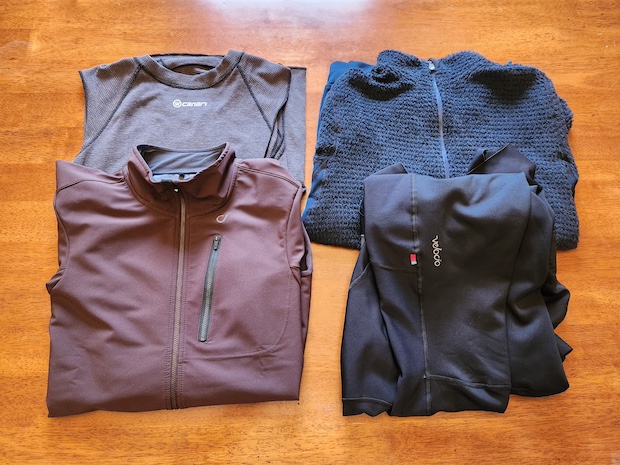
For the base layer, I almost always turn toward my trusty old merino wool mesh shirts from Canari. I received six of these (two sleeveless, two short sleeves, two long sleeves) from a road team I was co-managing and racing for in 2007. And, they remain in my regular rotation for most of the year. These are no longer available from Canari, and the closest I have found is the Velocio Merino Mesh Base Layers in sleeveless, short sleeves, and long sleeves. They are worth the investment because the wool lasts forever and doesn’t get funky over years of use. Velocio only sent the long sleeve merino wool base layer, so for today I opted to go sleeveless with the old Canari base layer.
Next, I put on the Velocio ZERO Bib Tights. These bib tights offer both thermal and wind protection, which I have found to be perfect for days with single digit wind speeds. For wind chill temps that dip into the teens and below, I find that I need an additional layer to protect my most sensitive areas. This means that I’ll turn to wearing thermal tights without a chamois over bibs or wearing wind pants (e.g., Verge cyclocross warm-up pants). However, I like having only one layer on the bottom and have pushed these ZERO Bib Tights as low as 20s with wind speed in the teens.
The next layer is the real hero of this story. I’ve never had a long sleeve jersey quite like this one. Velocio’s Alpha Long Sleeve has a fuzzy, insulating front and a thin breathable back. This provides a mid-layer between the wool base layer and a jacket that serves as shell. The fuzzy material on the front is a wool blend that is surprisingly warm. If you consider nothing else in this article, give this mid-layer piece a careful look.
The last layer for today was Velocio’s Signature Soft Shell Jacket. This shell is water resistant and breathable. It’s designed to be mixed and matched with different base and mid layers. This came as kind of a revelation to me. I was stuck in the mindset that a jacket had to do it all: warmth, breathability, water resistance. It never occurred to me to let the jacket do the breathability and the water resistance part, and to let the base and mid layers to do the thermal part. That makes so much more sense. If I need more thermal under this jacket, I wear both the Velocio Merino Wool long sleeve base layer and the Velocio Alpha Long Sleeve. And if I need less thermal, I skip the Alpha Long Sleeve. Pretty smart.
Selecting Accessories
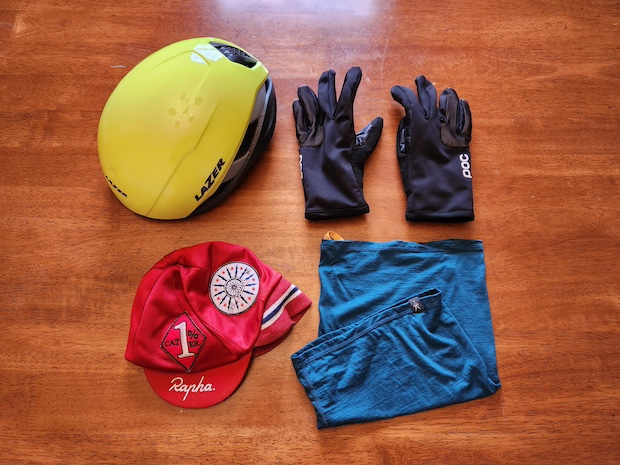
Winter riding with a neck gaiter is a must. It creates a seal so that you don’t have a gap at the back of your neck that can catch the wind, and you can pull it up over your face when needed. I had been riding with a coolmax-type gaiter for a while. However, when Ibex sent their Indie Quick Link Neck Gaiter made of merino wool, I felt foolish for not using wool on my neck before. Wool remains the best for pulling moisture off your skin and insulating for warmth. This is the only neck gaiter I use now.
For a hat, I use an old Rapha winter cap that was given to me as a gift. It has sentimental value from past adventures, so I also use it for a place to display patches from our local Buffalo Bicycling Club. Since I’m on the wool bandwagon, I should replace it with a merino wool winter cap. But, it’s doing a pretty good job for now.
To fit a helmet over a winter cap, you may need to size up. I typically wear a medium, but I requested the LAZER Strada Kineticore in large to fit over my hat comfortably. I also added the bright yellow Aeroshell for warmth and visibility. I recommend taking your winter cap to a bike shop to try on helmets to make sure it all fits safely and comfortably.
For gloves, I have found the POC Thermal Gloves to have quite a range of temperatures. They aren’t too bulky and they don’t get too saturated with sweat. They are pretty good for rides up to 3 hours. For anything beyond that, I prefer a merino wool glove liner and a lighter glove. Gloves get pretty useless once they are wet from the inside. I have also tried to use Bar Mitts, but I don’t like having my hands stuck in one position on the hoods.
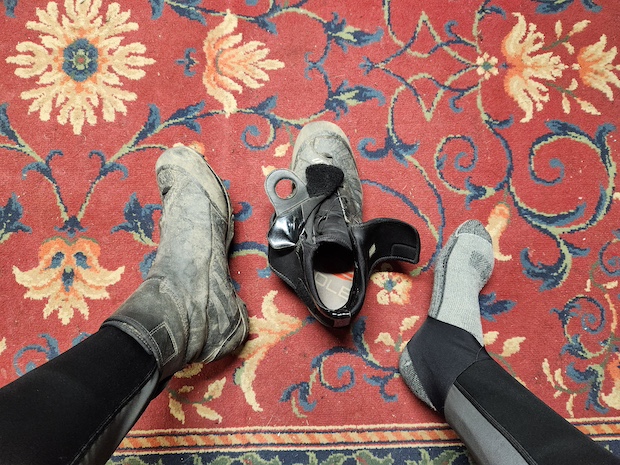
For my feet, I prefer to wear wool socks and thermal mountain bike boots. Any merino wool socks will do, but I do have different thicknesses that I choose from. The Specialized Defroster shoes are almost water proof (road spray and rain is no problem, but stepping in water will leak in) and are roomy for thick socks. This combination is good for temps down into the teens. If I ever need anything warmer, I put a chemical hand warmer on top of my toes.
Bike Choice
I have long been an advocate for running big tires in the winter. Historically, that meant a cyclocross bike, but now many of us have gravel bikes that accommodate 40+ mm tires. Increased rolling resistance equals slower speeds which equals less wind chill from headwinds. Simply put, slower is warmer. I am also somewhat of a fender evangelist. Keeping your butt dry and warm is so important, so install fenders to keep road spray off your body. Almost all of this thermal gear gets worse once it is saturated, so stay dry at all costs in the winter.
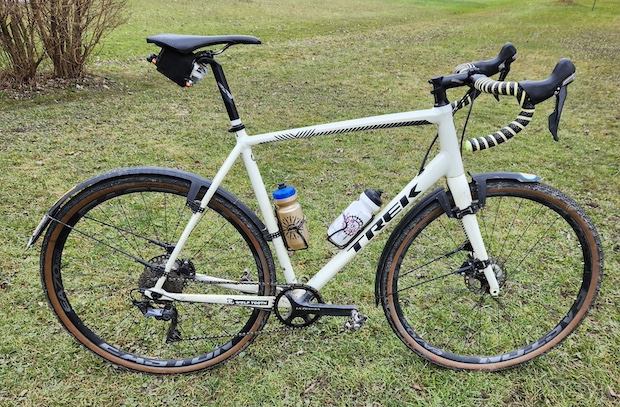
Though I have a very nice TIME ADHX 45 I am building with Shimano GRX 12 speed (which I’ll be writing about and reviewing soon), I most often turn to my 2019 Trek Crockett in the winter for riding through snow, ice, and salt-brined roads. With the sliding dropouts, this bike is a single-speed cyclocross bike for part of the year and what I call a “snow pig” for the rest of the year. Pictured is the full 1×11 snow pig setup with 40mm gravel tires and SKS Speedrocker fenders. A word of caution, if you do add strap-on fenders, protect your frame with 3M protection film at the points of attachment.
After the Ride
In general, I do not like to drive to ride. Especially so in the winter, I prefer to ride from my door and jump in the shower immediately after. I always want to get my wet riding clothes off and out of my chamois as soon as possible. I hate standing around in kit during or after a ride, so much more so when it is cold. However, there are exceptions when I’m at a race or a group event, and I have no choice but to drive there. In the winter, it’s worth thinking about what you will put on after the ride to get dry and warm, often in your car.
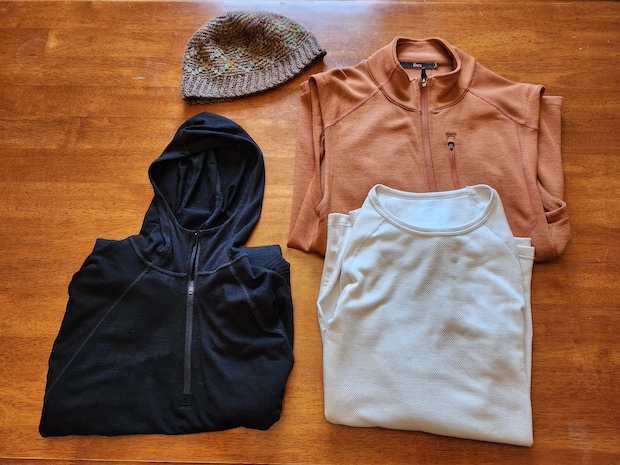
Ibex had sent their merino wool Indie Hoodie and Shak Vest. I never found a use for them for riding, so I started wearing them around the house. Then it hit me. Why was I putting on a cotton t-shirt in my car after a winter riding event? Why wasn’t I putting on a wool shirt to replace the wet wool I was stripping off? Fast forward and this merino wool hoodie and vest are my go-to post ride pieces for getting dry and warm fast while shivering in a car. My renewed interest in wool is shared by my wife, Erin, who crochets will all different types of wool yarn from around the world. She made me my go-to post-ride wool hat. She thinks the shape turned out ugly and wants to tear it down and start over, but I won’t let her. It’s too warm.

End Notes
Hopefully, there’s something helpful to your winter riding among all these details from today’s ride. Below is a list of some of the items mentioned in this piece.
Velocio ZERO Bib Tight On Sale $179.00
Velocio Merino Mesh SL Base Layer MSRP $79.00
Velocio Alpha Long Sleeve MSRP $199.00
Velocio Signature Soft Shell Jacket On Sale $161
Ibex Quick Link Neck Gaiter On Sale $31.50
Ibex Indie Hoody MSRP $170.00
Ibex Shak Vest MSRP $200.00
LAZER Strada Kineticore MSRP $109.99
LAZER Strada Kineticore Aeroshell MSRP $24.99


Start the discussion at slowtwitch.northend.network